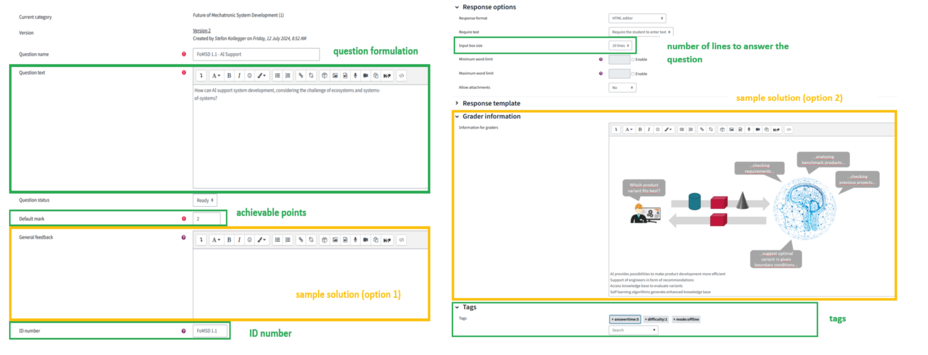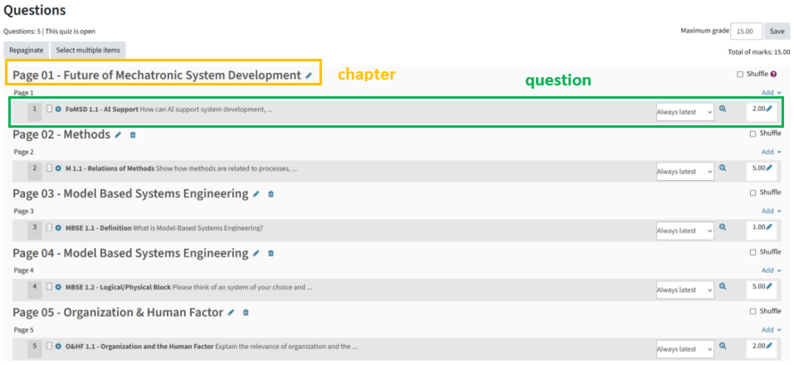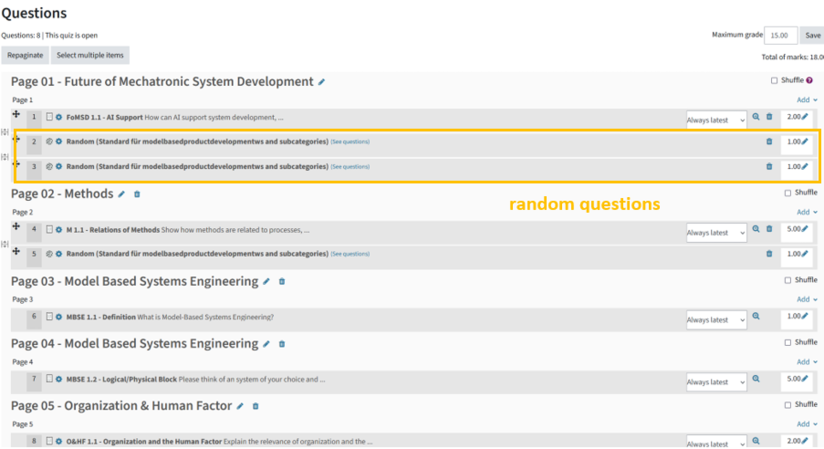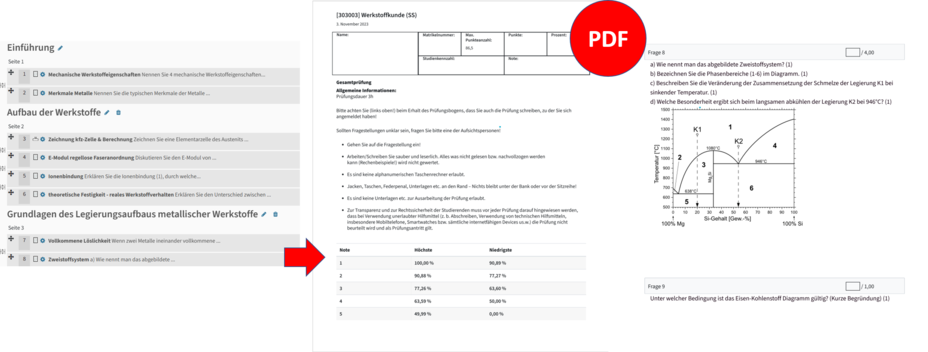Many teachers use tools such as Microsoft Office to create and manage exam questions for presence exams. This often makes it difficult to keep track of all the questions, keep them all up to date and derive new variants. It becomes even more complicated when several people are involved in creating the exam.
The TeachCenter Exam tool, an instance of the TeachCenter teaching and learning platform, addresses precisely this challenge. By using the new Exam Printer tool, exam questions can be easily created, edited and managed by all authorized persons.
Exam Printer can be used to generate presence exam sheets from existing question collections and export them as PDFs.
Using the question collection in the TeachCenter Exam offers the following advantages:
- Familiar TeachCenter environment for teachers at TU Graz to create and manage questions
- Data security and data protection in relation to the question collection
- Assign specific access rights to the question collection
- Use of existing question collections (as well as online exams)
- Use of various question types (free text, multiple choice, parameterized calculation, etc.)
- Structured collection of questions (categories, tags)
- Versioning of questions and question statistics for continuous quality improvement
The use of the Exam Printer tool offers further advantages:
- Use of the TeachCenter questionnaire also for presence exams
- Configure exam once and at the touch of a button
- Generate presence exam sheets with random questions
- Store and print sample solutions
- Individual design of the exam sheet
The path to the question collection for users
Exam questions are created and managed directly in the TeachCenter (Exam) question collection, which allows central accessibility for all participants (even across institutes). For each question, the sample solution can also be stored directly after the question text in the "General feedback" or "Evaluator information" field (image 1). If you later want to export an entire exam including a sample solution as a template for assessment via the Exam Printer, this is also created automatically.
If appropriate tags are used when the questions are initially created, you can structure your own collection of questions specifically. It is also possible to filter by tags when creating exams, i.e. when adding (random) questions to a specific test activity.
Use of tags for even more specific exam creation
"answertime:x" is the most important tag, where x stands for the answer time in minutes. If this tag is stored for all questions used in an exam, the Exam Printer Tool displays the predicted total time. This is a good indication of whether the created exam can be completed in the specified exam time.
For example, the tags "difficulty:y" and "type:z" can be assigned to better capture the level of difficulty and the focus of the exam when it is created. The assigned level of difficulty y is fundamental for the comparability of exams of different dates to ensure a consistent level. Z as a characterizing type can be specifically adapted to the course. Types such as calculation or sketch are centrally recommended. Other tags can be added as required.
In addition to tags, the ID number of a question can also be helpful in the creation process. This is particularly useful for quantifying the frequency of questions asked over longer periods of time.
Deriving an exam from the question bank
If the exam sheets are to be printed later for a presence exam, a test activity is first created in the TeachCenter (Exam) course. As with online exams, the structure is divided into different sections and pages and any number of questions from the question bank are assigned to each section (image 2). As can be seen in the examples, the specific examination requirements can be taken into account when structuring the exam. Now all that remains to be done in the Exam Printer is to make the PDF export settings. For example, the cover page can be edited here and formatting settings for questions can be defined. Once everything is configured, an attendance exam can be generated with a single click. You can find step-by-step instructions for the Exam Printer on the TELucation website.
Randomized question collection
Another automation option in the exam creation process: instead of self-selected questions, random questions can be added as placeholders in the test activity (image 3). The random questions can be filtered according to question categories and tags so that the resulting exam with specific questions is tailored as precisely as possible to your own requirements. In the Exam Printer, a specific exam containing specific questions from the question collection is created from this template with random questions with a single click. If the selection is not suitable, selected questions can be replaced, deleted or new questions added. Finally, the exam sheet and the sample solution can be exported as a PDF (image 4).
Once a template with random questions and the corresponding export settings has been created, future exams can be created automatically with a single click - a huge time-saver when creating exams.
What users say
By using the Exam Printer, we have not only been able to make our teaching processes more efficient at the institute, but have also optimized the creation of exam questions in the course of using the tool. A defined method and the consistent use of tags make it easier to manage the exam question collection and exam compilation. All in all, the Exam Printer improves both the processes for lecturers and the quality of examinations for students.
DI Clemens Faustmann, Institute of Machine Elements and Development Methodology, 2024
The combination of Exam Management and Exam Printer is a valuable addition to exam creation. By preparing standardized templates tailored to the respective course, the basic form of a new exam can be generated in a time-efficient manner without having to repeat it. By setting appropriate tags, the revision of this basic form is just as efficient and after a few adjustments the exam is ready.
This is certainly a tool that will gain a foothold in the field of teaching. Particularly in the academic environment, it will reduce the necessary capacities for handling examinations without having to accept any loss of quality.
Daniel Berger, BSc, Institute for Machine Elements and Development Methodology, 2024
I regularly offer around 10 exam dates per year for two courses and, if necessary, I also schedule an exam date. After I have created the collection of questions with sample solutions in the TeachCenter with strong support from our study assistants, it is possible to create a completely new exam within a few minutes with the Exam Printer at the touch of a button. As a rule, I then go through the questions again, check whether they are comprehensible and contain the necessary pictures and diagrams. I then print out the exam and sample solution and am ready for the exam in 20 minutes or less. With the Exam Printer, I now have a very well-functioning tool to quickly provide fair exams with very little effort.
Univ.-Prof. Norbert Enzinger, Institute of Materials Science, Joining and Forming Technology, 2024
![[Translate to Englisch:] [Translate to Englisch:]](https://www.tugraz.at/fileadmin/_processed_/c/0/csm_Suejt_Exam_Printer_3a8db8f43c.jpg)





![[Translate to Englisch:]](https://www.tugraz.at/fileadmin/_processed_/c/0/csm_Suejt_Exam_Printer_a4d3530090.jpg)

